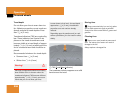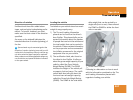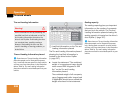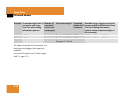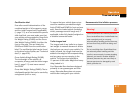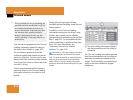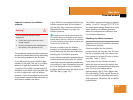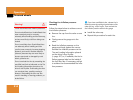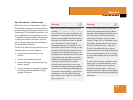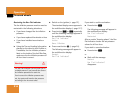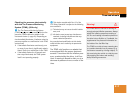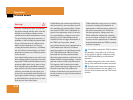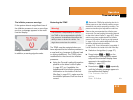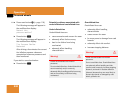
313
Operation
Tires and wheels
Important notes on tire inflation
pressure
Tire temperature and tire inflation pressure
are also increased while driving, depending
on the driving speed and the tire load.
If you will be driving your vehicle at high
speeds of 100 mph (160 km/h) or higher,
where it is legal and conditions allow,
consult the tire inflation pressure label (if
available) on the inside of the fuel filler flap
on how to adjust the cold tire inflation
pressure. If you do not adjust the tire infla-
tion pressure, excessive heat can build up
and result in sudden tire failure.
If your vehicle is not equipped with the tire
inflation pressure label on the inside of
the fuel filler flap, contact an authorized
Mercedes-Benz Center for proper tire
inflation pressure.
Be sure to readjust the tire inflation
pressure for normal driving speeds. You
should wait until the tires are cold before
adjusting the tire inflation pressure.
Some vehicles may have supplemental tire
inflation pressure information for vehicle
loads less than the maximum loaded vehi-
cle condition. If such information is provid-
ed, it can be found on the tire inflation
pressure label located on the inside of the
fuel filler flap (
୴ page 291).
Tire inflation pressure changes by approxi-
mately 1.5 psi (0.1 bar) per 18°F (10°C) of
air temperature change. Keep this in mind
when checking tire inflation pressure
where the temperature is different from
the outside temperature.
Checking tire inflation pressure
Regularly check your tire inflation pressure
at least once a month.
Check and adjust the tire inflation
pressure when the tires are cold. The tires
can be considered cold if the vehicle has
been parked for at least 3 hours or driven
less than 1 mile (1.6 km).
If you check the tire inflation pressure
when the tires are warm (the vehicle has
been driven for several miles or sitting less
than 3 hours), the reading will be
approximately 4 psi (0.3 bar) higher than
the cold reading. This is normal. Do not let
air out to match the specified cold tire in-
flation pressure. Otherwise, the tire will be
underinflated.
Warning! G
If the tire inflation pressure drops
repeatedly:
ț Check the tires for punctures from
foreign objects.
ț Check to see whether air is leaking from
the valves or from around the rim.
i
Driving comfort may be reduced when the
tire inflation pressure is adjusted to the value for
speeds above 100 mph (160 km/h) as specified
on the tire inflation pressure label located on the
inside of the fuel filler flap.




